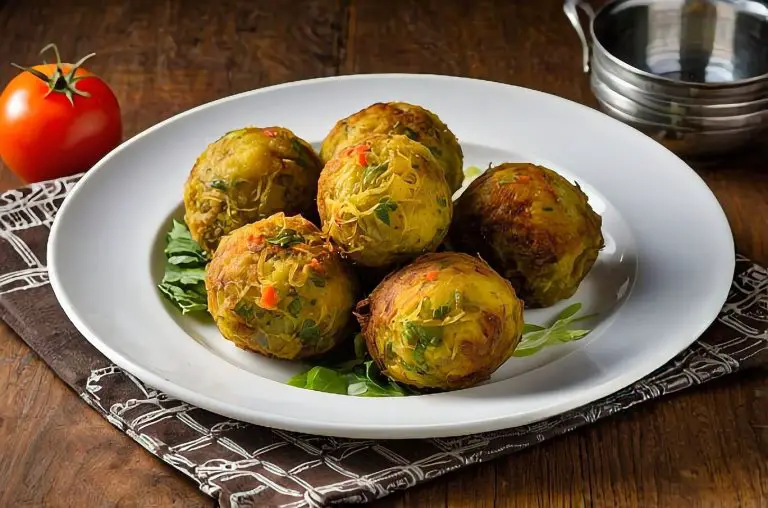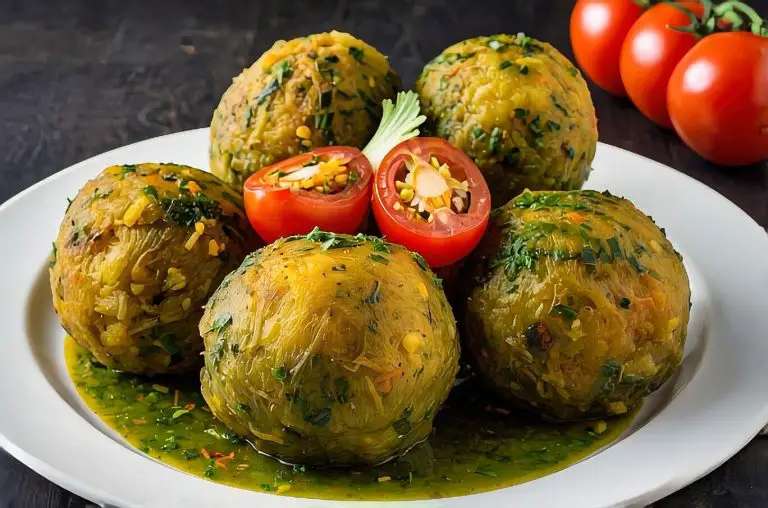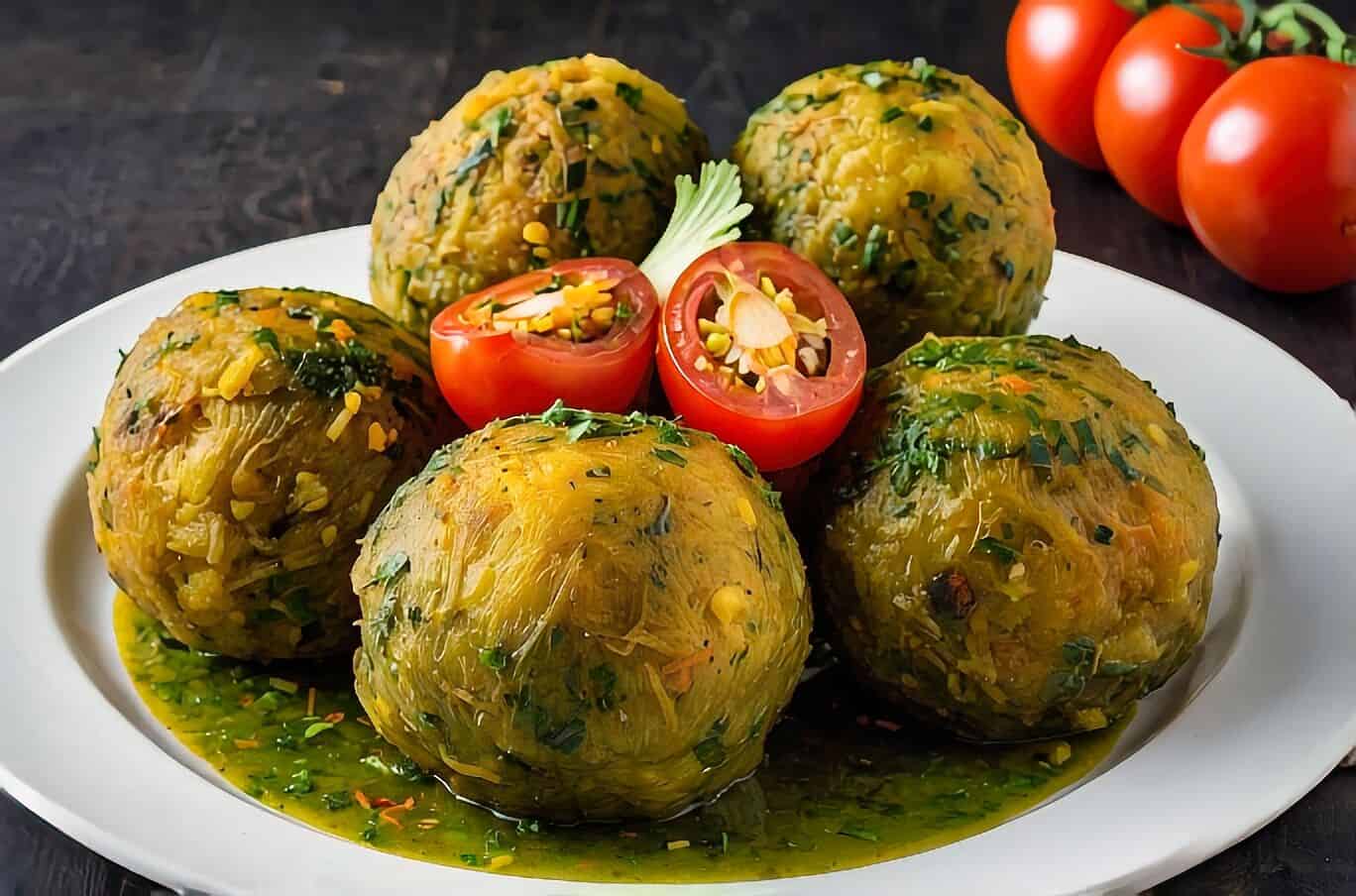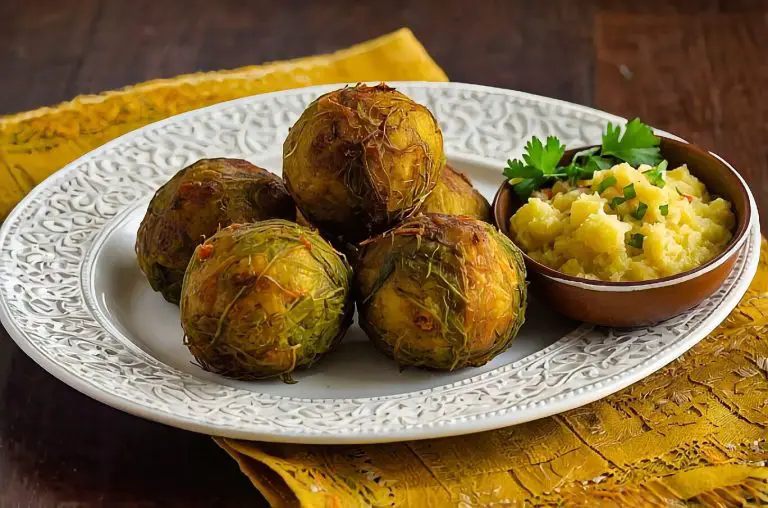Ecuador Bolon de Verde Recipe: When I think of delicious Ecuadorian breakfast dishes, bolón de verde always comes to mind. This savory treat is a staple in Ecuador and loved by many for its unique flavor and texture. Each bite is a delightful combination of mashed plantains with options for filling, like cheese or pork, making it an exciting dish to start the day.
Preparing bolón de verde takes some practice, but the result is definitely worth the effort. I enjoy experimenting with different ingredients, which makes each batch a little different. Whether you enjoy them as a breakfast item or a snack, these fried plantain balls will surely impress anyone who tries them.
If you’ve never tasted bolón de verde, you’re in for a treat! Join me as we explore how to make this traditional Ecuadorian recipe that brings comfort and joy with each fluffy bite.
Understanding Bolón de Verde
Bolón de verde is more than just a dish; it’s a flavorful part of Ecuadorian culture. I find it fascinating how this food connects to the country’s history and traditions.
Historical Background
Bolón de verde has roots that trace back to African influence in Ecuador. This dish is believed to have been introduced by African slaves brought to work in the fields. They used green plantains, which were readily available, to create a filling meal.
Over time, the recipe evolved. Ingredients like cheese and pork rinds were added based on local tastes. Bolón de verde became a staple food in Ecuador, enjoyed by many families.
Today, this dish is often part of breakfast or served as a snack. Families share recipes, passing down their unique variations through generations.
Cultural Significance
In Ecuadorian culture, food plays a vital role in gatherings and celebrations. Bolón de verde is often served during special occasions, making it a symbol of togetherness.
I’ve seen families come together to enjoy this dish, celebrating their heritage. The preparation of bolón de verde can include everyone, with each person contributing their touch to the recipe.
For many, this dish represents comfort and nostalgia, linking them to their roots. I appreciate how bolón de verde connects people, making meals a memorable experience filled with laughter and stories.
Selecting Ingredients
When making Bolón de Verde, the choice of ingredients is crucial for flavor and texture. I find that selecting the right plantains, cheese, and meat or vegetarian options makes all the difference in creating a delicious dish.
Choosing the Right Plantains
For Bolón de Verde, I always choose green plantains. These are firmer and less sweet than ripe ones, making them perfect for mashing. Look for plantains that are bright green and firm to the touch. Avoid any with dark spots, as they are likely overripe.
To prepare them, I peel and cut the plantains into chunks before boiling them. Some people may fry them instead for added flavor. Either way, cooking them until soft is essential for a smooth mash.
Types of Cheese and Alternatives
Cheese adds a creamy texture and rich flavor to Bolón de Verde. I like to use Queso Fresco, which is a mild, crumbly cheese that’s perfect for mixing into the plantains. It melts well and doesn’t overpower the dish.
If I can’t find Queso Fresco, I sometimes use grated cheese or even mozzarella. For a non-dairy option, a vegan cream cheese can provide a similar creaminess without the dairy.
Meats and Vegetarian Substitutes
Traditionally, I might add chicharrón, which is crunchy fried pork, to my Bolón de Verde for extra flavor. Bacon or chorizo can work as alternatives, offering a savory kick to the dumplings.
For vegetarian options, I recommend using sautéed mushrooms or smoked tofu. These choices can provide richness and depth of flavor while keeping the dish meat-free. No matter what, selecting quality ingredients will enhance the taste and enjoyment of this classic Ecuadorian dish.
Preparation Basics
When preparing Bolon de Verde, a few key steps ensure the best results. I will share the basics of creating the masa, how to mash the plantains properly, and tips for forming the bolones.
Creating the Perfect Masa
To make a great masa, I start with ripe green plantains. It’s important to choose plantains that are firm and green for that perfect texture.
- Peel and Chop: First, I peel the plantains and chop them into chunks.
- Cook: Next, I boil them in water until tender, which usually takes about 20-30 minutes. This step helps soften the plantains for easy mashing.
- Combine Ingredients: After draining, I mix in ingredients like queso fresco or chicharrones for flavor. Adding salt enhances the taste.
This creates a soft masa that is essential for my bolones.
Mashing Plantains
Mashing plantains is a crucial step. I always let the boiled plantains cool slightly before I begin.
Using a mortar and pestle is my preferred method, as it gives me control over the texture.
- Add Ingredients: I add any mix-ins like cheese or pork while mashing. This way, the flavors blend well.
- Achieve the Right Consistency: I aim for a consistency that is neither too smooth nor too lumpy. The right texture makes forming the bolones easier later.
Mashing is all about achieving an even consistency while keeping the delicious ingredients intact.
Forming the Bolones
Once my masa is ready, it’s time to form the bolones. This part is fun and allows for some creativity!
- Shape the Mixture: I take a handful of the masa and shape it into a ball, about the size of a baseball.
- Make a Hollow: To enhance the flavor, I sometimes press a little into the center and add a small amount of cheese or pork, then seal it back up.
- Fry: I heat oil in a pan and fry the shaped bolones until golden brown and crispy on the outside.
This step ensures a delightful crunch that contrasts beautifully with the soft inside.

Cooking Techniques
When making bolón de verde, different cooking techniques can affect the flavor and texture. I’ll share methods like frying, steaming, and baking so you can choose what suits you best.
Frying
Frying is the most popular way to prepare bolón de verde. I like using vegetable oil or lard for frying because they give the dumplings a crispy texture.
Here are the steps for frying:
- Shape the Mixture: First, I shape the green plantain mixture into balls and then heat the oil in a pan.
- Fry the Bolones: Once the oil is hot, I carefully add the balls, cooking them until they are golden brown on all sides. This usually takes about 4-5 minutes per batch. I keep an eye on them to ensure they don’t burn.
- Serve: Fried bolones are deliciously crunchy, and I often serve them with cooked chorizo or cheese for added flavor.
Steaming Options
Steaming is a healthier alternative to frying. For this method, I form the bolón de verde into balls but skip the frying.
Here’s how I steam bolones:
- Shape the Mixture: First, I shape the green plantain mixture into balls and set them aside.
- Steam the Bolones: Then, I place them in a steamer basket over boiling water and cover the pot. I let them steam for about 15-20 minutes.
- Add Flavor: Sometimes, I mix in herbs or spices to the filling for an extra taste boost.
Steaming keeps the flavors intact and results in a softer texture. While they won’t be crispy like fried ones, steamed bolones still have a rich flavor that I really enjoy.
Baking Variations
Baking bolón de verde is another option I like to explore. This method gives a different, less greasy texture while allowing the dumplings to puff up nicely.
Here are the steps for baking:
- Preheat the Oven: First, I preheat the oven to 375°F (190°C).
- Shape the Mixture: After shaping the dumplings, I place them on a baking sheet lined with parchment paper.
- Bake the Bolones: Then, I brush them lightly with oil for a nice finish. I bake them for about 25-30 minutes, flipping halfway through.
I often experiment with different fillings, such as cheese or spices, to keep things interesting.
Customizing Your Bolon
I love how customizable bolon de verde can be. It’s a dish that lets me express my taste and creativity. Whether I want to change the filling or adjust the spices, there are many ways to make it my own.
Varying the Fillings
When making bolon, I often think about what I want to include inside. The classic options are cheese and chicharrones, but I enjoy trying different things.
- Cheese: I usually use a mild cheese like queso blanco. It melts nicely and adds creaminess.
- Fried Egg: Sometimes, I add a fried egg for extra protein and flavor. The yolk adds richness when I bite into it.
- Chicharrones: These crispy pork pieces give a crunchy texture that I really enjoy.
I have also experimented with adding diced vegetables or even ground meat. Mixing different fillings can create a unique taste every time.
Adjusting Spices and Flavors
Spices are key to making my bolon stand out. I often use chili powder, cumin, and coriander to enhance the flavor. Here’s how I adjust:
- Chili Powder: I sprinkle in a bit to add heat. The amount depends on how spicy I want it.
- Cumin: This spice provides an earthy flavor. I usually go for a small pinch.
- Coriander: It adds a fresh, citrusy note. A little goes a long way.
I mix the spices into the plantain mash to ensure they are evenly distributed. This way, every bite is flavorful and satisfying. Experimenting with spices helps me find my perfect balance.
Ingredients For the Ecuador Bolon de Verde Recipe
Plantains
Butter
Salt
Queso Fresco Cheese
Vegetable Oil

Cooking Instructions For the Ecuador Bolon de Verde Recipe
Peel the plantains by cutting off the ends and slicing the peel (don’t cut too deep). Remove the peel with your fingers and knife, then cut the plantains into 1.5-inch chunks. Place them in a saucepan, cover with water, and simmer for 8 minutes before draining.
Transfer the plantains to a plate, add butter, and mash with a fork or potato masher, leaving some chunks. Mix in the salt and cheese, then shape the mixture into 10 balls.
Heat oil in a small pan to 350F, fry the bolón for about 3 minutes per side until golden brown. Remove and drain on paper towels. Serve warm, ideally soon after frying.

FAQ For the Ecuador Bolon de Verde Recipe
Question: What is the Ecuador Bolon de Verde recipe?
A: The Ecuador Bolon de Verde recipe is a traditional Ecuadorian dish made from green plantains, which are fried and then mashed with cheese, pork, or other fillings. It’s shaped into a ball and often served with a side of peanut sauce or a salad.
Question: How do you prepare the plantains for the Ecuador Bolon de Verde recipe?
A: For the Ecuador Bolon de Verde recipe, the green plantains are peeled, boiled, and then fried until golden. After frying, they are mashed and mixed with cheese or other ingredients, forming the signature bolon shape.
Question: What are the main ingredients in the Ecuador Bolon de Verde recipe?
A: The main ingredients in the Ecuador Bolon de Verde recipe are green plantains, cheese, pork, or other fillings. Some variations include adding onions, garlic, or herbs for extra flavor.
Question: Can I make the Ecuador Bolon de Verde recipe without pork?
A: Yes, the Ecuador Bolon de Verde recipe can be made without pork. You can use cheese, chicken, or even vegetables as a substitute for the pork, depending on your dietary preferences.
Question: What side dishes pair well with the Ecuador Bolon de Verde recipe?
A: The Ecuador Bolon de Verde recipe pairs well with sides like salad, fried egg, or avocado. You can also enjoy it with a spicy salsa or peanut sauce for added flavor.

Easy Ecuador Bolon de Verde Recipe
Ingredients
- 2 plantains green
- 2 Tbsp butter unsalted
- 1/2 tsp salt
- 1 c queso fresco crumbled (or shredded mozzarella cheese)
- 1/4 c vegetable oil for frying
Instructions
- Peel the plantains by cutting off the ends and slicing the peel (don’t cut too deep). Remove the peel with your fingers and knife, then cut the plantains into 1.5-inch chunks. Place them in a saucepan, cover with water, and simmer for 8 minutes before draining.
- Transfer the plantains to a plate, add butter, and mash with a fork or potato masher, leaving some chunks. Mix in the salt and cheese, then shape the mixture into 10 balls.
- Heat oil in a small pan to 350F, fry the bolón for about 3 minutes per side until golden brown. Remove and drain on paper towels. Serve warm, ideally soon after frying.
Nutrition



3 comments
What made this recipe a winner for me was how everything came together so perfectly. The combination of flavors felt well thought out, and it didn’t feel too heavy or bland. It had just the right amount of richness without being overpowering.
I personally find the historical background of Bolón de Verde fascinating! Its amazing how a simple dish can hold so much cultural significance. Makes me appreciate it even more when I make it at home.
I never knew Bolón de Verde had such a rich history and cultural significance! Makes me appreciate it even more. Who knew selecting the right ingredients could make such a difference? Mind blown!